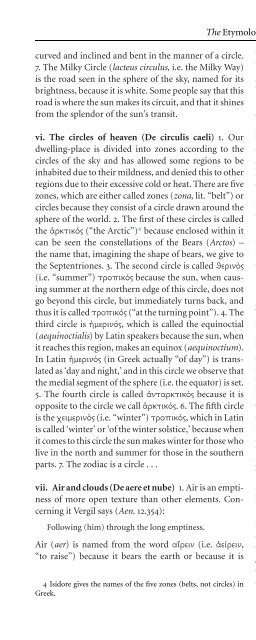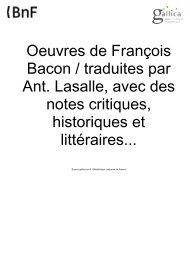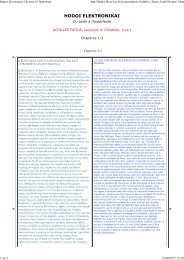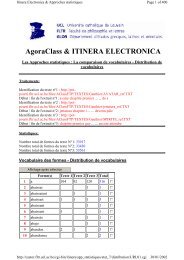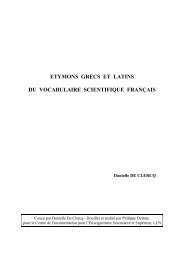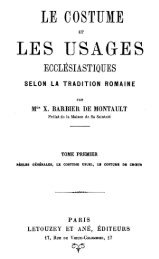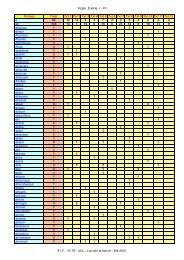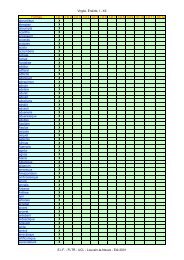The Etymologies of Isidore of Seville - Pot-pourri
The Etymologies of Isidore of Seville - Pot-pourri
The Etymologies of Isidore of Seville - Pot-pourri
You also want an ePaper? Increase the reach of your titles
YUMPU automatically turns print PDFs into web optimized ePapers that Google loves.
curved and inclined and bent in the manner <strong>of</strong> a circle.<br />
7. <strong>The</strong>Milky Circle (lacteus circulus, i.e. the Milky Way)<br />
is the road seen in the sphere <strong>of</strong> the sky, named for its<br />
brightness, because it is white. Some people say that this<br />
road is where the sun makes its circuit, and that it shines<br />
from the splendor <strong>of</strong> the sun’s transit.<br />
vi. <strong>The</strong> circles <strong>of</strong> heaven (De circulis caeli) 1. Our<br />
dwelling-place is divided into zones according to the<br />
circles <strong>of</strong> the sky and has allowed some regions to be<br />
inhabited due to their mildness, and denied this to other<br />
regions due to their excessive cold or heat. <strong>The</strong>re are five<br />
zones, which are either called zones (zona,lit.“belt”)or<br />
circles because they consist <strong>of</strong> a circle drawn around the<br />
sphere <strong>of</strong> the world. 2. <strong>The</strong> first <strong>of</strong> these circles is called<br />
the (“the Arctic”) 4 because enclosed within it<br />
can be seen the constellations <strong>of</strong> the Bears (Arctos) –<br />
the name that, imagining the shape <strong>of</strong> bears, we give to<br />
the Septentriones. 3. <strong>The</strong>second circle is called <br />
(i.e. “summer”) because the sun, when causing<br />
summer at the northern edge <strong>of</strong> this circle, does not<br />
go beyond this circle, but immediately turns back, and<br />
thus it is called (“at the turning point”). 4.<strong>The</strong><br />
third circle is , whichiscalled the equinoctial<br />
(aequinoctialis)byLatin speakers because the sun, when<br />
it reaches this region, makes an equinox (aequinoctium).<br />
In Latin (in Greek actually “<strong>of</strong> day”) is translated<br />
as ‘day and night,’ and in this circle we observe that<br />
the medial segment <strong>of</strong> the sphere (i.e. the equator) is set.<br />
5. <strong>The</strong>fourth circle is called because it is<br />
opposite to the circle we call . 6.<strong>The</strong>fifth circle<br />
is the (i.e. “winter”) ,whichin Latin<br />
is called ‘winter’ or ‘<strong>of</strong> the winter solstice,’ because when<br />
it comes to this circle the sun makes winter for those who<br />
live in the north and summer for those in the southern<br />
parts. 7.<strong>The</strong>zodiac is a circle . . .<br />
vii. Air and clouds (De aere et nube) 1.Airisan emptiness<br />
<strong>of</strong> more open texture than other elements. Concerning<br />
it Vergil says (Aen. 12.354):<br />
Following (him) through the long emptiness.<br />
Air (aer) isnamedfromtheword (i.e. ,<br />
“to raise”) because it bears the earth or because it is<br />
4 <strong>Isidore</strong> gives the names <strong>of</strong> the five zones (belts, not circles) in<br />
Greek.<br />
<strong>The</strong> <strong>Etymologies</strong> XIII.v.7–ix.1 273<br />
borne. <strong>The</strong> term refers partly to earthy and partly to<br />
heavenly material. That which is very fine, where winds<br />
and tempests cannot exist, makes up the celestial part,<br />
but that which is more turbulent, which takes on bodily<br />
substance with exhalations <strong>of</strong> moisture, is defined as<br />
earthy; it gives rise to many forms <strong>of</strong> itself. For when it<br />
is stirred, it makes winds; when more vehemently agitated,<br />
it makes lightning and thunder; when compressed,<br />
clouds; when condensed, rain; when it has frozen clouds,<br />
snow; when denser clouds freeze with more turbulence,<br />
hail; when it expands, bright weather. Thus dense air is<br />
cloud, and dispersed and loosened cloud is air.<br />
2.Clouds (nubes)are named from ‘veiling’ (obnubere),<br />
that is, covering the sky; whence also brides (nupta),<br />
because they veil their faces, and also Neptune (Neptunus),<br />
because he casts a veil (nubere), that is, covers<br />
the sea and earth. <strong>The</strong> condensation <strong>of</strong> air makes clouds,<br />
for the winds lump the air together and make a cloud,<br />
whence this in Vergil(Aen. 5.20):<br />
And the air is forced into a cloud.<br />
viii. Thunder (De tonitruo) 1.Thunder (tonitrus)isso<br />
named because the sound <strong>of</strong> it terrifies, for a tone (tonus)<br />
is a sound. Sometimes this shakes everything so violently<br />
that it seems to have split the sky, because, when a blast<br />
<strong>of</strong> very violent wind suddenly throws itself into clouds,<br />
with an increasingly powerful whirlwind seeking an exit,<br />
with a great crash it tears through the cloud, which it<br />
has hollowed out, and thus thunder is carried to the<br />
ears with a horrendous din. 2.Noone should be amazed<br />
at this, since when a vessel explodes it makes a loud<br />
noise, however small it is. A flash <strong>of</strong> lightning is produced<br />
at the same time as the thunder, but it is seen sooner<br />
because it is bright; thunder reaches the ears later. <strong>The</strong><br />
light that appears before the thunder is called a ‘lightning<br />
bolt’ (fulgetra). As we have said, it is seen first because<br />
its light is bright, and the thunder comes to one’s ears<br />
later.<br />
ix. Lightning (De fulminibus) 1. Lightning (fulgur)<br />
and the ‘lightning bolt’ (fulmen), the strokes <strong>of</strong> a celestial<br />
dart, are named from ‘striking’ (ferire); for to ‘flash’ (fulgere)<br />
isto‘strike’ and to ‘cut through.’ Colliding clouds<br />
cause lightning, for the collision <strong>of</strong> any things creates fire,<br />
as we notice with stones, and the rubbing <strong>of</strong> wheels, and<br />
in forests <strong>of</strong> trees; in a similar way fire occurs in clouds.


